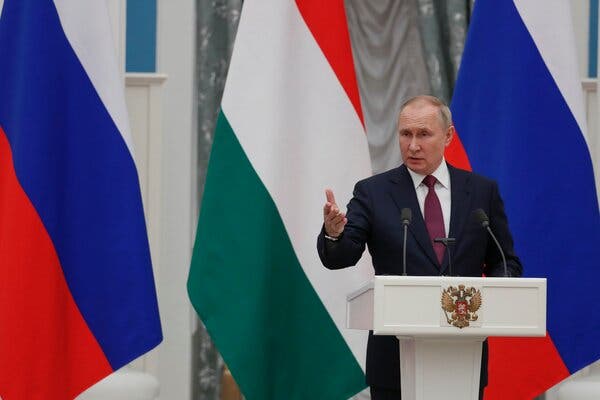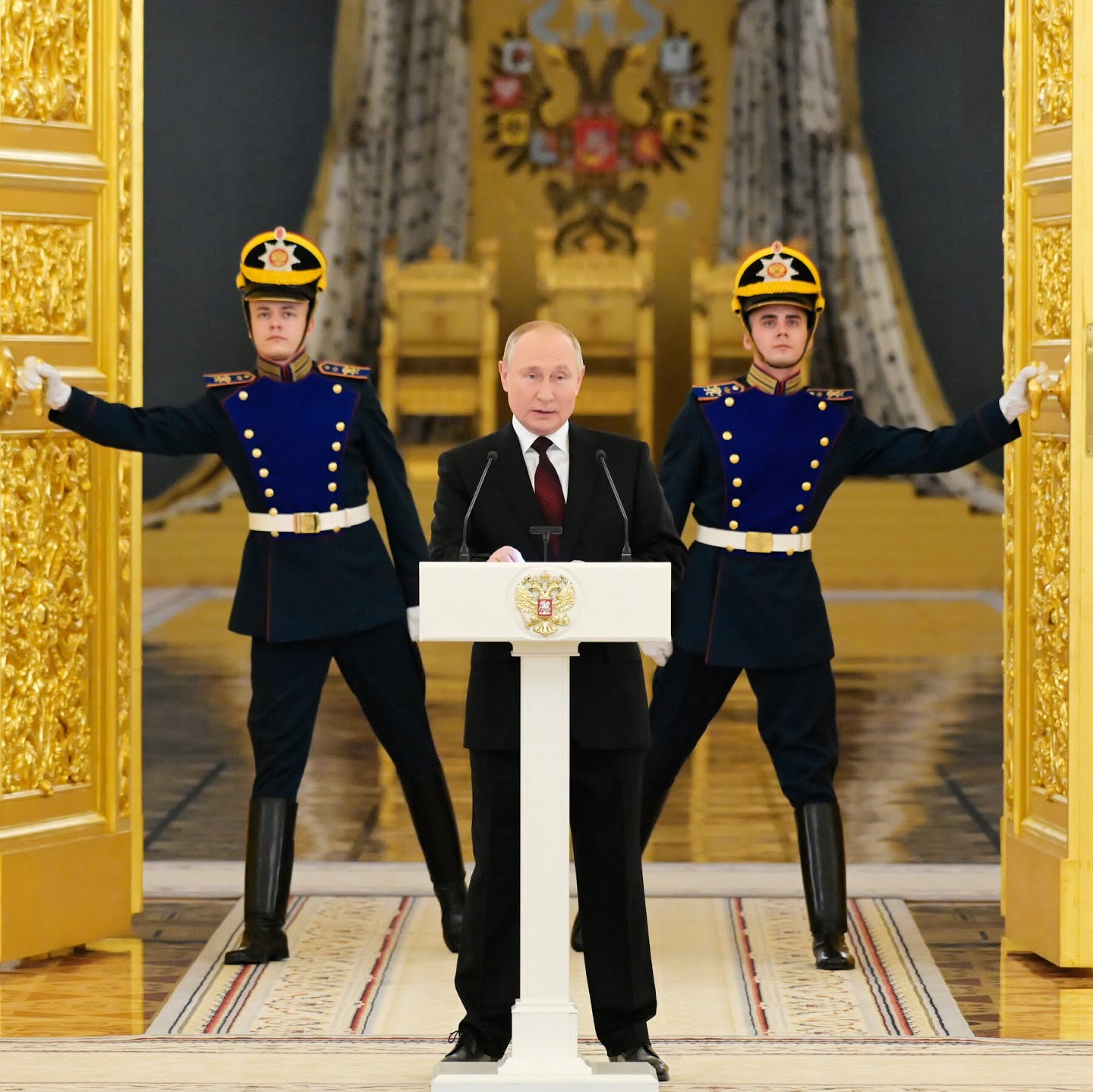•The Biden administration’s goal is to cut the Russians off at each turn by exposing their plans. But Russian President Vladimir V. Putin says that approach could spark a conflict.
By David E. Sanger
At key moments since the Ukraine crisis flared into the headlines two months ago, President Biden and his aides have worked to expose Russian President Vladimir V. Putin’s plans, declassifying intelligence about his next steps and calling him out as an “aggressor.”
The administration has revealed information that could only have been obtained by penetrating, at least to some degree, Russia’s military and intelligence systems. The Pentagon declared publicly that the force Mr. Putin was assembling on three sides of Ukraine would reach 175,000 or more before an invasion began, a piece of data one cannot discern from looking at a satellite photograph.
A few weeks later, it said Moscow would try to stage a provocation — a “false flag attack” on its own forces or allies — to create a pretext to act. Then Washington encouraged the British to reveal a Russian plan to install a puppet government in Kyiv.
Each one of those revelations was part of a strategy to get ahead of the Russians in an area where Moscow has long excelled: information warfare.
But the disclosures also raised the issue of whether, in trying to disrupt Moscow’s actions by revealing them in advance, the administration is deterring Russian action or spurring it on. The administration’s goal is to cut the Russians off at each turn by exposing their plans and forcing them to think of alternative strategies. But that approach could provoke Mr. Putin at a moment when American intelligence officials believe he has not yet decided whether to invade.
Democracies are usually terrible at information warfare, and American officials insist there is a difference between what they are doing and the dark arts that Mr. Putin made famous.
Russia often makes up its narratives, and its officials have no problem with lying outright, as they did when Mr. Putin created a pretext to annex Crimea in 2014, sent operatives to use nerve agents against Russian opposition leader Alexei A. Navalny and a former Russian spy in Britain, and launched a series of cyberattacks on the United States.
Understand Russia’s Relationship With the West
The tension between the regions is growing and Russian President Vladimir Putin is increasingly willing to take geopolitical risks and assert his demands.
- Competing for Influence: For months, the threat of confrontation has been growing in a stretch of Europe from the Baltic Sea to the Black Sea.
- Threat of Invasion: As the Russian military builds its presence near Ukraine, Western nations are seeking to avert a worsening of the situation.
- Energy Politics: Europe is a huge customer of Russia’s fossil fuels. The rising tensions in Ukraine are driving fears of a midwinter cutoff.
- Migrant Crisis: As people gathered on the eastern border of the European Union, Russia’s uneasy alliance with Belarus triggered additional friction.
- Militarizing Society: With a “youth army” and initiatives promoting patriotism, the Russian government is pushing the idea that a fight might be coming.
The American and British warnings, officials insist, are drawn from what they view as a credible stream of intelligence assessments, and have been backed up by commercial satellite photography and Twitter posts showing a massive force assembling on Ukraine’s borders.

Naturally, officials refuse to talk about how they obtained the underlying information about Russia’s plans. But several of the disclosures have triggered debates about whether the U.S. or its allies risked giving away their sources and methods, the most precious resource in the intelligence world.
“Regardless of how this plays out, it will be a great case study in the pre-emptive use of intelligence,’’ said Paul R. Kolbe, the former chief of the C.I.A.’s Central Eurasia Division, who worked in Russia as Mr. Putin rose and now directs the Intelligence Project at Harvard.
But already that strategy of raising alarms has triggered some discomfort.
Ukraine’s leadership has objected to the American characterization that an invasion is “imminent” — or even likely. “They make it as acute and burning as possible,’’ President Volodymyr Zelensky complained the other day, a point he made more vividly to Mr. Biden in a phone call last week. “In my opinion, this is a mistake.”

The source of Mr. Zelensky’s concern is understandable: He doesn’t want to panic his population, tank the Ukrainian stock market, or watch investors and foreign executives race to the airport. And Mr. Biden’s communications aides have toned it down a little bit, dropping the word “imminent” from their warnings of a Russian invasion.
“We stopped using it because I think it sent a message that we weren’t intending to send, which was that we knew President Putin had made a decision,” the White House press secretary, Jen Psaki, acknowledged during a briefing.
But other administration officials said they thought they saw signs that Mr. Putin himself was thrown a bit by the aggressive U.S. approach. At a news conference on Tuesday, he accused the White House of reviving the Cold War strategy of containment — and then said he thought the Biden administration was trying to goad him into an attack, as an excuse to trigger sanctions.
Understand the Escalating Tensions Over Ukraine
A brewing conflict. Antagonism between Ukraine and Russia has been simmering since 2014, when the Russian military crossed into Ukrainian territory, annexing Crimea and whipping up a rebellion in the east. A tenuous cease-fire was reached in 2015, but peace has been elusive.
A spike in hostilities. Russia has recently been building up forces near its border with Ukraine, and the Kremlin’s messaging toward its neighbor has hardened. Concern grew in late October, when Ukraine used an armed drone to attack a howitzer operated by Russian-backed separatists.
Ominous warnings. Russia called the strike a destabilizing act that violated the cease-fire agreement, raising fears of a new intervention in Ukraine that could draw the United States and Europe into a new phase of the conflict.
The Kremlin’s position. President Vladimir V. Putin of Russia, who has increasingly portrayed NATO’s eastward expansion as an existential threat to his country, said that Moscow’s military buildup was a response to Ukraine’s deepening partnership with the alliance.
Rising tension. Western countries have tried to maintain a dialogue with Moscow. But administration officials recently warned that the U.S. could throw its weight behind a Ukrainian insurgency should Russia invade.
“In this sense, Ukraine itself is just an instrument to achieve this goal,” he said. “This can be done in different ways, by drawing us into some kind of armed conflict and, with the help of their allies in Europe, forcing the introduction against us of those harsh sanctions they are talking about now in the U.S.”
But to many inside the administration, what Mr. Putin omitted was more important than what he said. There was no threat that the United States and NATO must yield to his demands that troops leave the former Soviet bloc nations that are now part of NATO, and that all nuclear weapons be removed from Europe, or he will be forced into what he has previously and mysteriously called “military/technical means.” It may have been a temporary omission.
And Mr. Putin did say that the American and NATO responses, the text of which leaked to a Spanish newspaper, addressed none of his core concerns. But he suggested there was still some time for diplomacy, striking a very different tone from his demand a few weeks ago that he needed “written guarantees,’’ and needed them immediately.
Some who have jousted with Mr. Putin for years saw a man looking for a way out.
William B. Taylor Jr., a longtime diplomat who served as the U.S. ambassador to Ukraine, said on Wednesday that he thought Mr. Biden’s more aggressive posture — a shift he calls “from passive deterrence to active deterrence” — was working.
“I think Putin has already blinked in some sense,’’ Mr. Taylor, who burst into public view when he testified at the impeachment hearings of President Donald J. Trump, said in an interview. “He was in a stare-down. And now he is looking for a way out. He’s overplayed his hand, and he may, for a while, settle for entering negotiations on a series of topics.”
Others are not so sure.
Some Russia experts inside and outside the government say that while Mr. Putin is seeking respect for Russia as a great power and real attention to his security needs — complaints that the West has largely ignored — lengthy negotiations over new arms control treaties or reciprocal limits on troop movements and exercises are unlikely to satisfy him. He will want concrete concessions now, in this view, before he can pull back from the border.
Several administration officials say they think Mr. Putin’s interest in diplomacy is purely tactical, and temporary. They suspect he doesn’t have all his forces amassed yet and may not want to cross President Xi Jinping of China by invading just as the Winter Olympics are beginning in Beijing. Mr. Putin is emerging from a long Covid-related isolation to join the celebration later this week, and he will use the moment to meet with Mr. Xi, with whom he has formed something of an alliance of convenience.
The Olympics end around Feb. 20, and the administration’s Russia hands say that will be the time to assess whether they have had any impact. Perhaps, they say, Mr. Putin will test Mr. Biden by trying to take more territory in the Russian-speaking east and south. Perhaps he will try to undermine the Zelensky government by turning off the power, or communications.
But several echoed Mr. Biden’s statement two weeks ago at a news conference, when he said, “My guess is he will move in. He has to do something.”
David E. Sanger is a White House and national security correspondent. In a 38-year reporting career for The Times, he has been on three teams that have won Pulitzer Prizes, most recently in 2017 for international reporting. His newest book is “The Perfect Weapon: War, Sabotage and Fear in the Cyber Age.” @SangerNYT • Facebook
Credits | NYT

